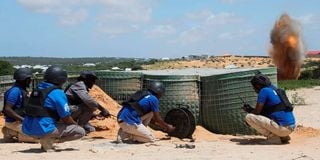
Somali police unit for Explosive Ordnance Disposal (EOD) detonates a controlled explosion of recovered mines on the outskirts of Mogadishu, Somalia May 27, 2024.
Over a decade ago, Kenya’s Permanent Representative to the UN and chair of the UN Peacebuilding Commission, Macharia Kamau, famously declared: “We need to build a peace industrial complex.” This was a clarion-call for a radical shift from supplying weapons, equipment and services in conflict-zones to peace-building.
Somalia appears to be on the cusp of a transition to peace and development. Today, the country is a member of the East African Community (EAC); the Inter-Governmental Authority on Development (IGAD); the African Union; and the United Nations Security Council, representing Africa on a non-permanent status.
After two decades in the wilderness, the country has re-entered the global financial system. More significantly, as the African Transition Mission in Somalia (ATMIS) exits Somalia on December 31, 2024, the African Union Support and Stabilization Mission in Somalia (AUSSOM), focusing on peacebuilding, will enter on January 1, 2025.
In the light of this, a new generation of African scholars, diplomats and policymakers are advocating for the rollback of the current military-industrial complex (MIC) — consisting mainly of networks of organisations, facilities, and resources that continue to supply governments (and even non-state actors) with weapons, equipment and defence-related services. Instead, they are pushing for the more benign ‘peace-industrial complex’ (PIC) — simply defined as all approaches and programs aimed at fostering sustainable peace and development, including peacemaking, peacebuilding and conflict resolution.
Global military expenditure
That said, rolling back the dominance of the extant military-industry complex is easier said than done. Amid war, rising tensions and insecurity across the world, the total global military expenditure reached an all-time high of over $2.4 trillion in 2023. The global economic impact of violence in 2023 stood at US$19.1 trillion or US$2,380 per each of the world’s 8 billion people.
Even worse, major powers only pay lip-service to the idea of advancing a ‘peace-industrial complex’ to undergird a peaceful, equitable, just and prosperous multi-polar world order. Expenditure on peacebuilding and peacekeeping totalled $49.6 billion, representing less than 0.6 percent of total military spending. As of June 2022, the total budget of the United Nations peacekeeping missions for the July 2021 to June 2022 fiscal year was US$6.3 billion.
The million dollar question is: Can the prevailing geopolitics in the Horn of Africa, including the spill-over effects of geopolitical rivalries in the Gulf region, allow the region to effectively transit to a peace-industrial complex regime?
Internally, since 2022, the government of President Hassan Sheikh Mahmoud, manifestly the most dedicated to end the al-Shabaab menace, has moved to entrench a peace-industrial complex. It has used a comprehensive four-pronged strategy to drain the swamps of violent extremism, effectively putting the al-Shabaab on the backfoot. First, it has targeted the group militarily using the Somali National Army (SNA) troops backed by local militias, ATMIS and international partners. Second it has waged the war on the economic front by curtailing the revenue sources for the militants, cutting out extortion rings and getting banks to freeze accounts linked to the financiers of the militants. Ideologically, it has de-campaigned the militia as criminals and outcasts. Finally, the government has encouraged defections and building capacity to receive defectors. As a result, the government has registered major victories and taken back territories that were previously under al-Shabaab.
Manifestly, achieving a peace-industrial complex is the thinking driving the transition and financing of the mission to succeed ATMIS. On August 1, 2024 the AU Peace and Security Council (PSC) adopted the Concept of Operations (CONOPs) for AUSSOM, which calls for political commitments, ensuring predictable financing, and strengthening global partnerships for peace operations targeting the roots of conflicts.
Peace-industrial complex
The transition to a peace-industrial complex is also at the heart of the on-going consultations to agree on the overall mission design and financing options for AUSSOM, involving the main stakeholders on Somalia, including the AU, UN, Federal Government of Somalia (FGS), Troop Contributing Countries (Kenya, Djibouti, Uganda, Burundi and Ethiopia) and international partners such as the US, UK, EU, Qatar, China, and Turkey.
Regionally, the move to a peace-industrial complex has ran against the headwinds of Ethiopia’s push for access to the Red sea, which led to the controversial port deal with Somaliland, a secessionist region in Somalia. Ethiopia has been a troops contributing country to AMISOM and ATMIS and has deployed additional troops in Somalia under a bilateral arrangement with the FGS. But Mogadishu now insists that Ethiopia should not be part of AUSSOM or continue to have its troops on the Somali soil after ATMIS’ exit unless it denounces the port deal. Ethiopia has, in turn, played on clan politics in parts of Jubbaland and South-West regions to cast its forces as the better suited to defend Somalia from al-Shabaab.
Somalia has decried Ethiopia’s hidden hand in parts of South West region where locals went to the streets to protest Mogadishu decision to stop cooperating with Addis Ababa. In September, Somalia accused Ethiopia of shipping weapons to its semi-autonomous state of Puntland, which in early August announced it had withdrawn from the country’s federal system and will govern itself independently until constitutional amendments passed by the central government were approved in a nationwide referendum.
For long, an arms embargo the UN Security Council first imposed on Somalia in the early 1990s has been a millstone around the neck of Somalia in its fight against the terrorists. Although getting the Security Council to lift the arms embargo is one of the diplomatic triumphs of President Hassan, which offers Somalia the best chance to defeat the militia, it has also intensified geopolitical rivalry and arms race between Egypt and Ethiopia. Ethiopia has accused Cairo of arming Somalia, with the risk that arms delivered to Mogadishu could end up in al-Shabaab’s hands. Regional and international partners should now focus on building a united front against al-Shabaab.
Professor Peter Kagwanja is Chief Executive at the Africa Policy Institute and Adjunct Scholar at University of Nairobi and the National Defence University, Kenya.








